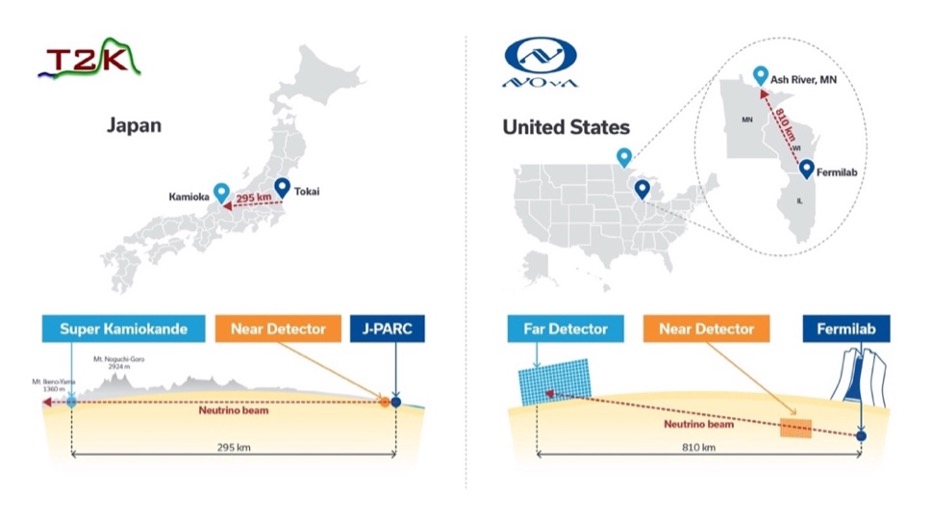T2K and NOvA constrain matter-antimatter differences using neutrino oscillations
Published: 23 October 2025
Teams from the international T2K and NOvA collaborations, including members from the School of Physics and Astronomy of the University of Glasgow, today published a paper in the prestigious scientific journal Nature, performing precision measurements of the differences between neutrinos and antineutrinos, by combining the data of the T2K and NOvA long-baseline neutrino oscillation experiments in Japan and the USA.
Teams from the international T2K and NOvA collaborations, including members from the School of Physics and Astronomy of the University of Glasgow, have published a paper in the prestigious scientific journal Nature, performing precision measurements of the differences between neutrinos and antineutrinos, by combining the data of the T2K and NOvA long-baseline neutrino oscillation experiments in Japan and the USA.
Differences between the way neutrinos and antineutrinos behave could be the reason why matter prevailed over antimatter in the early Universe soon after the Big Bang. The research published today puts the strongest constraints on this matter-antimatter difference observed in neutrinos, known technically as the breaking of the Charge-Parity (CP) symmetry.
The research was carried out in the T2K experiment in Japan and the NOvA experiment in the USA. Neutrinos, and their antimatter counterparts the antineutrinos, come in three types called flavours: electron-, muon- and tau-neutrinos, and can change from one flavour to another as they travel. The T2K experiment sends muon (anti-)neutrinos on a journey of 295 km from the J-PARC complex in Tokai (Ibaraki Prefecture) on the east coast of Japan to the 55-kilotonne Super-Kamiokande detector underneath the Japanese Alps in Kamioka (Gifu Prefecture), where they may transform to the electron flavour. The NOvA experiment sends (anti-)neutrinos from Fermilab, near Chicago (Illinois) for 810 km to a 14 kilotonne far detector in Ash River (Minnesota).

T2K in Japan (left) and NOvA in the United States (right) are both long-baseline neutrino experiments, in which an intense beam of neutrinos travels hundreds of kilometres to be detected at a far detector.
By alternately studying beams of neutrinos and antineutrinos, the experiments can look for differences between how physics treats matter and antimatter, the Charge-Parity symmetry breaking. Since the (anti-)neutrinos traverse the regular matter of the Earth, the measurements are also dependent on the pattern (ordering) of neutrino masses, which can be Normal (the same as all other matter particles) or Inverted.
This can also produce a difference between neutrinos and antineutrinos, so teasing this apart from a real breaking of the Charge-Parity symmetry is critical.
Working independently since 2010 the two experiments came to different conclusions about the combination of effects. Now for the first time, these two experiments have joined forces to create a unique common analysis of all their combined data. The difference in energy and baseline of T2K and NOvA makes the two experiments complementary.
The combined analysis is the most sensitive constraint on Charge-Parity symmetry in neutrino oscillations. Results from NOvA and T2K present a consistent picture if the ordering is Inverted, clearly favouring a difference between neutrinos and antineutrinos. But if the neutrino mass ordering is Normal, more data will be required to determine if neutrino oscillations really do show a difference between matter and antimatter.
Members of the University of Glasgow, led by Dr Phillip Litchfield and Professor Paul Soler, are members of the T2K collaboration and had leading contributions to the T2K-NOvA combined analysis, showing that the two apparently contradictory measurements are still highly consistent with a single model.
This was commenced by Dr Evan Goodman, who completed his PhD thesis on this analysis, and continued by Dr Veera Mikola, a postdoctoral Research Assistant at Glasgow who previously worked on NOvA.
The T2K experiment is supported in Japan by the Japanese Ministry of Culture, Sports, Science and Technology (MEXT) and is funded in the UK by the Science and Technology Facilities Council (STFC), in collaboration with other international funding agencies.
Dr Phillip Litchfield, who led the Glasgow T2K-NOvA effort, said “I’m very proud of our researchers who showed the two experiments fit a consistent pattern. This was not clear when we started, and it is critical for this to be demonstrated for any other conclusions to be drawn from the joint analysis. Although the final picture is not clear yet, it’s fascinating that combination makes the Inverted ordering more plausible and would point to an even deeper puzzle after we have an answer for the Charge-Parity question.”
Professor Paul Soler said: "This has been a unique collaboration between two competing experiments, with the key goal of understanding the difference between matter and antimatter in neutrino and antineutrino oscillations. It is through international scientific collaboration that we can increase the impact of each experiment on its own.”
Dr Veera Mikola said: “Even though T2K and NOvA are considered ‘competing’ experiments having worked in both, first as a PhD student in NOvA and now as a postdoc in T2K, it has shown me we all share the same enthusiasm and interest for neutrino physics. This analysis is a culmination of a lot of work from many people across the globe; it’s an exciting day to celebrate the scientific milestone we have achieved together!”
Dr Evan Goodman said: “This is an incredible milestone that shows dedication and teamwork of two very different global experiments. These results stand as a testament to the collective goal of advancing our understanding of neutrino physics, and what can be achieved together, despite being ‘competitors’. It was an absolute privilege to work with both T2K and NOvA during my PhD, and everyone in both collaborations should be immensely proud.”
Further information can be found in the T2K press release.
First published: 23 October 2025
Related links
- Dr Phillip Litchfield
- Professor Paul Soler
- Dr Veera Mikola
- School of Physics & Astronomy
- NOvA
- T2K
- Link to paper in Nature

